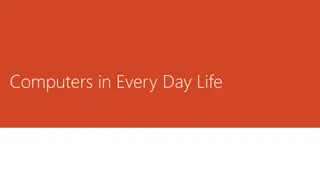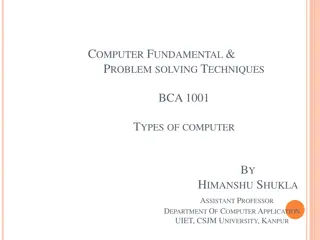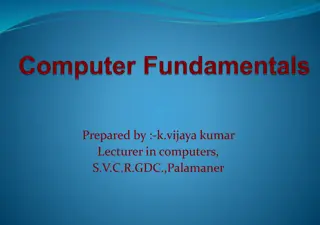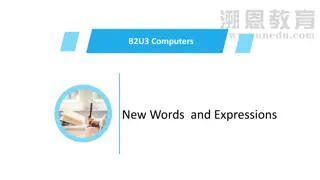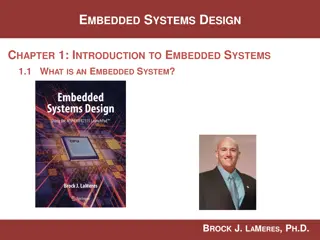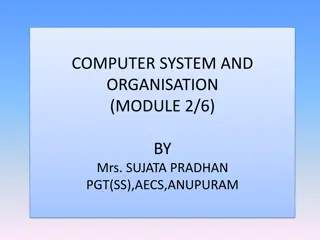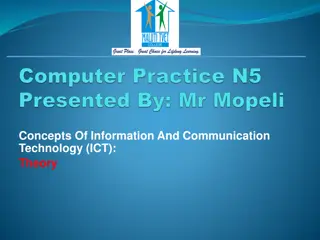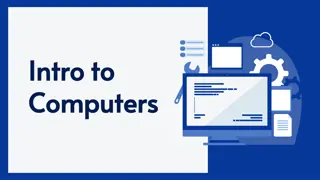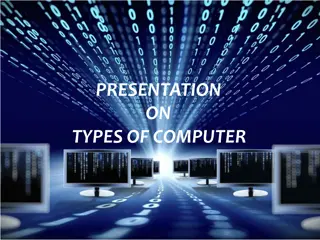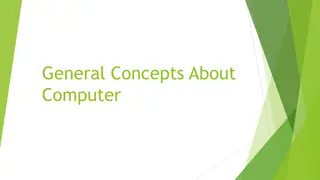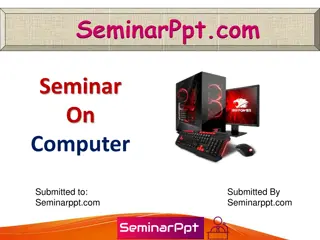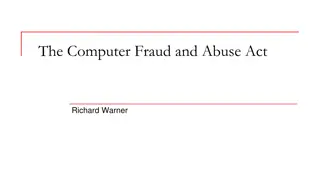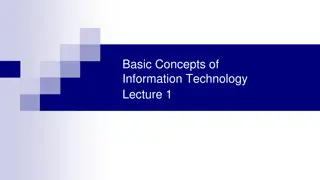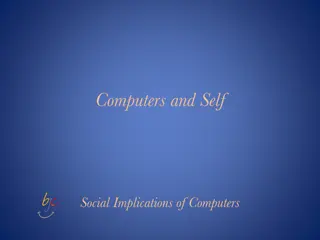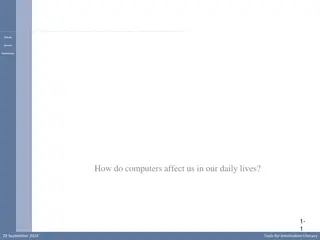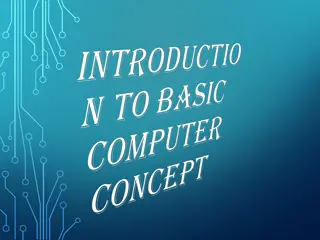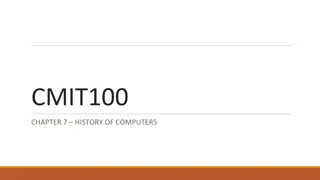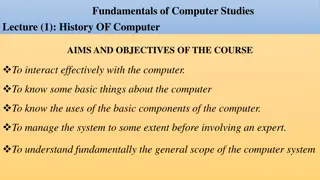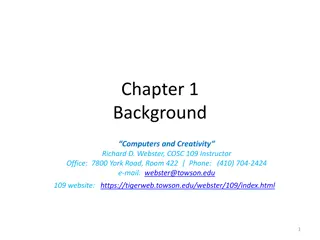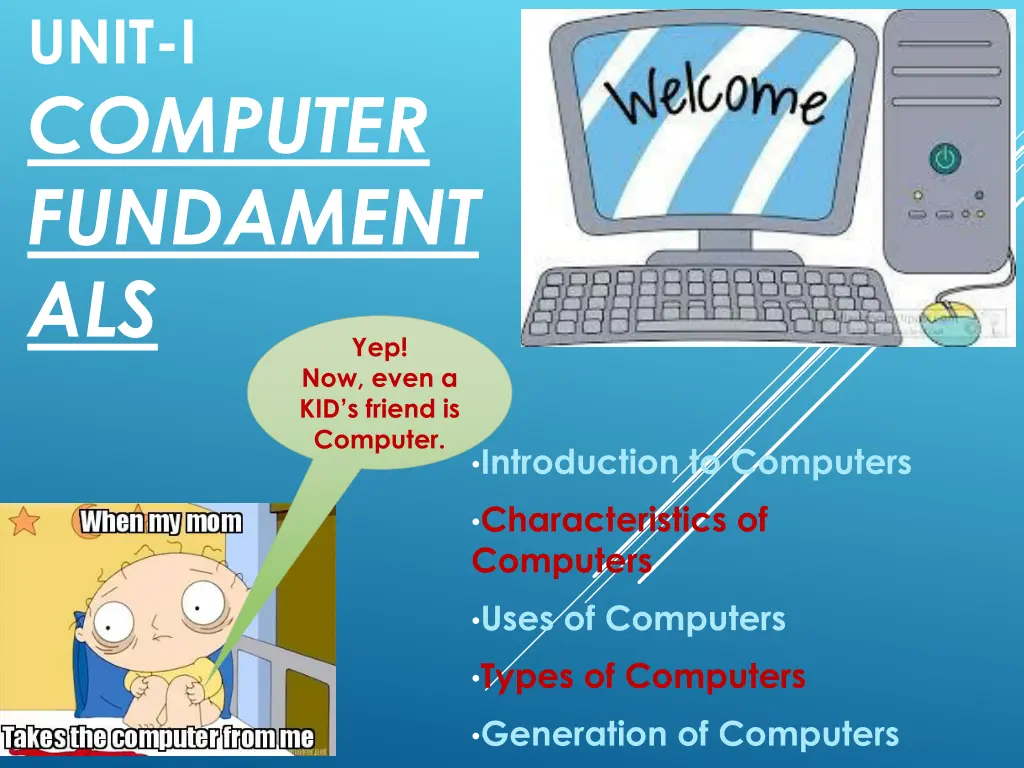
Understanding Computers: Introduction, Data, and Information
Delve into the world of computers with an overview of their characteristics, uses, types, and more. Explore the concepts of data versus information, and grasp the essence of net neutrality.
Download Presentation

Please find below an Image/Link to download the presentation.
The content on the website is provided AS IS for your information and personal use only. It may not be sold, licensed, or shared on other websites without obtaining consent from the author. If you encounter any issues during the download, it is possible that the publisher has removed the file from their server.
You are allowed to download the files provided on this website for personal or commercial use, subject to the condition that they are used lawfully. All files are the property of their respective owners.
The content on the website is provided AS IS for your information and personal use only. It may not be sold, licensed, or shared on other websites without obtaining consent from the author.
E N D
Presentation Transcript
UNIT-I COMPUTER FUNDAMENT ALS Yep! Now, even a KID s friend is Computer. Introduction to Computers Characteristics of Computers Uses of Computers Types of Computers Generation of Computers
Computer is an electronic device that receives input, stores or processes the input as per user instructions and provides output in desired format. WHAT S A COMPUTER
Computer input is called data and the output obtained after processing it, based on user s instructions is called information. Raw facts and figures which can be processed using arithmetic and logical operations to obtain information are called data. WHAT S A COMPUTER
Data is defined as the collection of facts and details like text, figures, observations, symbols or simply description of things, event or entity gathered with a view to drawing inferences. It is the raw fact, which should be processed to gain information. It is the unprocessed data, that contains numbers, statements and characters before it is refined by the researcher. The term data is derived from Latin term datum which refers to somethinggiven . DATA VS. INFORMATION
Information is described as that form of data which is processed, organised, specific and structured, which is presented in the given setting. It assigns meaning and improves the reliability of the understandability and When the data is transformed into information, it is free from unnecessary details or immaterial things, which has some value to the researcher. data, reduces thus ensuring uncertainty. The term information discovered from the Latin word informare , which refers to give form to . DATA VS. INFORMATION
Net neutrality is the principle that individuals should be free to access all content and applications equally, regardless of the source, without Internet Service Providers discriminating against specific online services or websites. In other words, it is the principle that the company that connects you to the internet does not get to control what you do on the internet.
The basic parts of a computer are as follows Input Unit Devices like keyboard and mouse that are used to input data and instructions to the computer are called input unit. Output Unit Devices like printer and visual display unit that are used to provide information to the user in desired format are called output unit. Control Unit As the name suggests, this unit controls all the functions of the computer. All devices or parts of computer interact through the control unit. BASIC PARTS OF A COMPUTER
Arithmetic Logic Unit This is the brain of the computer where all arithmetic operations and logical operations take place. Memory All input data, instructions and data interim to the processes are stored in the memory. Memory is of two types primary memory and secondary memory resides within secondary memory is external to it. Control unit, arithmetic logic unit and memory are together called the unit or CPU. memory. the CPU Primary whereas central processing BASIC PARTS OF A COMPUTER
High Speed 1. It is capable of performing calculation of very large amount of data. The computer has units of speed in microsecond, nanosecond, and even the picosecond. It can perform millions of calculations in a few seconds as compared to man who will spend many months to perform the same task. Accuracy 2. In addition to being very fast, computers are very accurate. Computers perform all jobs with 100% accuracy provided that the input is correct. ADVANTAGES OF COMPUTERS
Storage Capability 3. Memory is a very important characteristic of computers. A computer has much more storage capacity than human beings. It can store large amount of data. It can store any type of data such as images, videos, text, audio, etc. Diligence 4. Unlike human beings, a computer is free from monotony, tiredness, and lack of concentration. It can work continuously without any error and boredom. It can perform repeated tasks with the same speed and accuracy. ADVANTAGES OF COMPUTERS
Versatility 5. A computer is very flexible in performing the jobs to be done. This machine can be used to solve the problems related to various fields. At one instance, it may be solving a complex scientific problem and the very next moment it may be playing a card game. Reliability 6. A computer is a reliable machine. Modern electronic components have long lives. Computers are designed to make maintenance easy ADVANTAGES OF COMPUTERS
Automation 7. Automation is the ability to perform a given task automatically. Once the computer receives a program i.e., the program is stored in the computer memory, then the program and instruction can control the program execution without human interaction. Reduction in Paper Work and Cost 8. The use of computers for data processing in an organization leads to reduction in paper work and results in speeding up the process. As data in electronic files can be retrieved as and when required, the problem of maintenance of large number of paper files gets reduced. ADVANTAGES OF COMPUTERS
No I.Q. A computer is a machine that has no intelligence to perform any task. Each instruction has to be given to the computer. A computer cannot take any decision on its own. Dependency It functions as per the user s instruction, thus it is fully dependent on humans. Environment The operating environment of the computer should be dust free and suitable. No Feeling Computers have no feelings or emotions. 1. 2. 3. 4. DISADVANTAGES OF COMPUTERS
CLASSIFICATION/ TYPES OF COMPUTERS
Classification By Technology Used According to the technology used, computers are of following three types: 1. Digital computers 2. Analog computers 3. Hybrid computers CLASSIFICATION BY TYPE/ TECHNOLOGY USED
Digital Computers: 1. Digital computers are mainly general purpose computers that represent and store data in discrete quantities or numbers. In these computers, all processing is done in terms of numeric representation (binary digits) of data and information. Although the user enters the data in decimal or character form, it is converted into binary digits (0s and 1s). For example: PC, Laptop etc. CLASSIFICATION BY TYPE/ TECHNOLOGY USED
Analog Computers: 2. Analog computers are special purpose computers that represent and store data in continuously varying physical quantities such as current, voltage or frequency. These computers are programmed for measuring physical quantities like pressure, temperature, speed, etc., and to perform computations on these measurements. Analog computers are mainly used for scientific and engineering applications. CLASSIFICATION BY TYPE/ TECHNOLOGY USED
Some of the examples of Analog computers are: Thermometer: It is a simple analog computer used to measure temperature. Speedometer: Car s speedometer is another example of analog computer where the position of the needle on dial represents the speed of the car. Limitations of the Analog computer: These do not have logical facilities afforded by programming. They do not have the ability to store data in large quantities. Cost of implementation of computation is very high. 1. 2. 3. CLASSIFICATION BY TYPE/ TECHNOLOGY USED
Hybrid computers: Hybrid computers incorporate the technology of both analog and digital computers. These computers store and process analog signals which have been converted into discrete numbers using analog to digital converters. They can also convert the digital numbers into analog signals or physical properties using digital to analog converters. Hybrid computers are mainly used in artificial intelligence (robotics) manufacturing (e.g., process control). For example: Automated Teller Machine (ATM). 3. and computer aided CLASSIFICATION BY TYPE/ TECHNOLOGY USED
Microcomputers: 1. Microcomputers are also called personal computers (PCs) and use microprocessor as its CPU, a memory unit, and input device and an output device. They are small in size. Also, they do not have large storage capacities. are more commonly computers because they are designed to be used by one person at a time. They called personal Popular uses for microcomputers include word processing, surfing the Web, sending and receiving e-mail, spreadsheet calculations, database management, editing photographs, creating graphics, and playing music or games. Few examples are IBM PC, PS/2, Apple II and Macintosh. CLASSIFICATION BY SIZE AND CAPACITY:
Minicomputers: 2. A minicomputer is a multi-user computer. They have high processing speed and high storage capacity than the microcomputers. Minicomputers can support 4-200 users simultaneously. They are used for real-time applications in industries, research centers etc. CLASSIFICATION BY SIZE AND CAPACITY: E.g. PDP-11, IBM (8000 series)
Mainframe Computers: 3. Mainframe programming and high performance computers. Computers are multi-user, multi- They operate at a very high speed, have very large storage capacity and can handle the workload of many users. These are generally used in centralized databases. Mainframe computers are used in organizations like banks or companies, where many people require frequent access to the same data. E.g. CDC 6600 and IBM ES000 series. CLASSIFICATION BY SIZE AND CAPACITY:
Supercomputers: 4. These are the largest and fastest computers. A super computer has a number of CPUs which operate in parallel to make it faster. They are used for massive data processing and solving very sophisticated problems i.e., in the fields of science and defense, designing and launching missiles, weather forecasting, biomedical research, aircraft design and automobile design. E.g. CRAY 3. India has a series of super computers called PARAM developed by C-DAC and ANURAG. CLASSIFICATION BY SIZE AND CAPACITY:
Nadir: the lowest or most unsuccessful point in a situation, the bottom E.g. asking that question was nadir of my career. Paper Bag Day is celebrated on 12 July globally every year to make people aware about the use of paper bags that contribute to fight with climate change and environment pollution.
General Purpose Computer: General-purpose computer is the one that can work on different types of programs input to it and thus be used in countless applications. The programs are not permanently stored but are input at the time of execution. These computers are very versatile. Simply by using a general purpose computer and different software, various accomplished, including writing and editing (word processing), manipulating facts in a data base, tracking manufacturing inventory, making scientific calculations etc. tasks can be CLASSIFICATION BY PURPOSE
Special Purpose Computer: Special-purpose computer is the one that is designed to perform a specific task. The instructions (programs) to carry out the task are permanently stored in the machine. For the specific tasks, this type of computer works efficiently but such computers are not versatile. Such a computer system would be useful in playing graphic intensive Video Games, traffic lights control system, navigational system in an aircraft, weather forecasting, satellite launch / tracking etc. CLASSIFICATION BY PURPOSE
First Generation (1940 to 1956): Using Vacuum Tubes Hardware Technology: The first generation of computers used vacuum tubes for circuitry and magnetic drums for memory. The input to the computer was through punched cards and paper tapes. The output was displayed as printouts. COMPUTER GENERATIONS
First Generation (1940 to 1956): Using Vacuum Tubes Software Technology : The instructions were written in machine language. Machine language uses 0s and 1s for coding of the instructions. The first generation computers could solve one problem at a time. Computing Characteristics: The computation time was in milliseconds. Physical Appearance: These computers were enormous in size and required a large room for installation. COMPUTER GENERATIONS
First Generation (1940 to 1956): Using Vacuum Tubes Application: They were used for scientific applications as they were the fastest computing device of their time. Examples: UNIVersal Automatic Computer (UNIVAC), Electronic Numerical Integrator And Calculator (ENIAC), Electronic Discrete Variable Automatic Computer (EDVAC) COMPUTER GENERATIONS
Disadvantages of 1st Generation: The first generation computers used a large number of vacuum tubes and thus generated a lot of heat. They consumed a great deal of electricity and were expensive to operate. The malfunctioning maintenance. machines were and prone required to frequent constant Since first generation computers used machine language, they were difficult to program. COMPUTER GENERATIONS
Second Generation (1956 to 1963): Using Transistors Hardware Technology : Transistors replaced the vacuum tubes of the first generation of computers. Transistors allowed computers to become smaller, faster, cheaper, energy efficient and reliable. The second generation computers used magnetic core technology for primary memory. They used magnetic tapes and magnetic disks for secondary storage. The input was still through punched cards and the output using printouts. They used the concept of a stored program, where instructions were stored in the memory of computer. COMPUTER GENERATIONS
Second Generation (1956 to 1963): Using Transistors Software Technology: The instructions were written using the assembly language. Assembly language uses mnemonics like ADD for addition and SUB for subtraction for coding of the instructions. High-level programming languages, such as early versions of COBOL and FORTRAN were also developed during this period COMPUTER GENERATIONS
Second Generation (1956 to 1963): Using Transistors Computing Characteristics : The computation time was in microseconds. Physical Appearance : Transistors are smaller in size compared to vacuum tubes, thus, the size of the computer was also reduced. Examples: PDP-8, IBM 1401 and CDC 1604 The cost of commercial production of these computers was very high, though less than the first generation computers. The transistors had to be assembled manually in second generation computers COMPUTER GENERATIONS
Third Generation (1964 to 1971): Using Integrated Circuits: Hardware Technology: The Integrated Circuit (IC) chips. third generation computers used the In an IC chip, multiple transistors are placed on a silicon chip. The use of IC chip increased the speed and the efficiency of computer, manifold. The keyboard and monitor were used to interact with the third generation computer, instead of the punched card and printouts. COMPUTER GENERATIONS
Third Generation (1964 to 1971): Using Integrated Circuits: Software Technology : The keyboard and the monitor were interfaced through the operating system. Operating system allowed different applications to run at the same time. High-level languages were used extensively for programming, instead of machine language and assembly language. Computing Characteristics: The computation time was in nanoseconds. COMPUTER GENERATIONS
Third Generation (1964 to 1971): Using Integrated Circuits: Physical Appearance : The size of these computers was quite small compared to the second generation computers. Examples: IBM 370, PDP 11. The third generation computers used less power and generated less heat than the second generation computers. The cost of the computer reduced significantly, as individual components of the computer were not required to be assembled manually. The maintenance cost of the computers was also less compared to their predecessors. COMPUTER GENERATIONS
Fourth Microprocessors Hardware Technology: Generation (1971 to present): Using They use the Large Scale Integration (LSI) and the Very Large Scale Integration (VLSI) technology. Thousands of transistors are integrated on a small silicon chip using LSI technology. VLSI allows hundreds of thousands of components to be integrated in a small chip. Microprocessor is a chip containing millions of transistors and components, and, designed using LSI and VLSI technology. memory magnetic core memory, resulting in fast random access to memory. Semiconductor replaced the earlier Secondary storage device like magnetic disks became smaller in physical size and larger in capacity. COMPUTER GENERATIONS
Fourth Microprocessors Generation (1971 to present): Using The linking of computers is another key development of this era. The computers were linked to form networks that led to the emergence of the Internet. This generation also saw the development of pointing devices like mouse, and handheld devices. Software Technology: Several new operating systems like the MS-DOS and MS- Windows developed during this time. This generation of computers supported Graphical User Interface (GUI). GUI is a user-friendly interface that allows user to interact with the computer via menus and icons. High-level programming languages are used for the writing of programs. COMPUTER GENERATIONS
Fourth Generation (1971 to present): Using Microprocessors Computing Characteristics: The computation time is in picoseconds. Physical Appearance : They are smaller than the computers of the previous generation. Ted Hoff produced the first microprocessor in 1971 for Intel. It was known as Intel 4004. COMPUTER GENERATIONS
Fifth Generation (Present and Next): Using Artificial Intelligence: The goal of fifth generation computing is to develop computers that are capable of learning and self- organization. The fifth generation computers use Super Large Scale Integrated (SLSI) chips that are able to store millions of components on a single chip. These computers have large memory requirements. generation of processing that allows several instructions to be executed in parallel, instead of serial execution. Parallel processing results in faster processing speed. This computers uses parallel COMPUTER GENERATIONS
Fifth Generation (Present and Next): Using Artificial Intelligence: Quantum and nanotechnology will radically change the face of computers in years to come. computation and molecular The goal of fifth-generation computing is to develop devices that respond to natural language input and are capable of learning and self-organization. COMPUTER GENERATIONS
Auxiliary: functioning in a subsidiary capacity, supplementary e.g. Graduating from big-name schools translates into better jobs and higher salaries, according to conventional wisdom. the auxiliary benefits that also lead to cash powerful alumni networks, name recognition that attracts the interest of hiring managers Plus, there are
PODCAST: A podcast is a type of digital media, usually audio, that is available in a series of episodes or parts downloaded by the end user over the Internet. Podcasts can be made available via a release schedule or uploaded to the Web randomly. and is streamed or
Difference between Computer Architecture and Computer Organization: Computer Architecture is a functional description of requirements and design implementation for the various parts of computer. It deals with functional behavior of computer system. It comes before the computer organization while designing a computer. Computer Organization comes after the decide of Computer Architecture first. Computer Organization is how operational attribute are linked together and contribute to realize the architectural specification. Computer Organization relationship. deals with structural BASIC COMPUTER ORGANIZATION
Architecture describes what the computer does. Organization describes how it does it. BASIC COMPUTER ORGANIZATION


